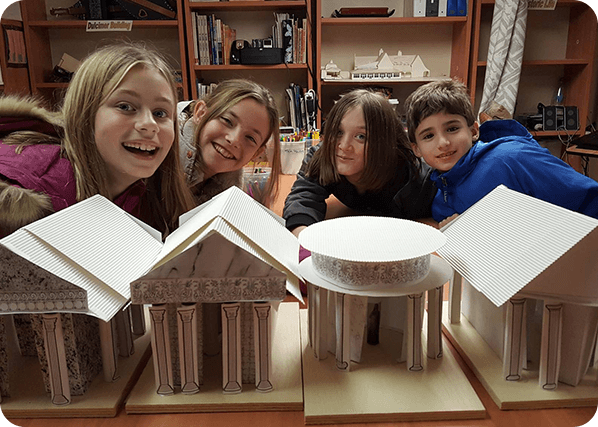10, 9, 8, 7, 6, 5, 4, 3, 2, 1…. Time Travelers go back to Mesopotamia, where they learn cuneiform writing and fashion their own tablets, and end the year with the high adventure of a European explorer facing the unknown to discover new lands. G∙tec happenings illuminate the time, place, and a people’s contribution to world civilization, through exciting, hands-on simulations and experiences.
Traveling back to Ancient Egypt, Time Travelers become scribes and are hired to create hieroglyphics and ornamentation for a pharaoh’s tomb. Returning to the present day and working for the Metropolitan Museum of Art, they become forensic scientists at New York Hospital. They read actual MRIs and X-Rays to determine how a particular mummy died.
Venturing into Ancient China and India is great fun. Time Travelers play a game using an abacus. They learn the ancient martial arts of Tai Chi, a method of soft and slow vs hard and fast movements. Time Travelers become acupuncture specialists and soothe patients’ suffering by determining the points that alleviate their pain. Students become calligraphers and try their hand at writing some of the ancient scripts with pen and ink. In Ancient India, Time Travelers design Mendi floor mats, create a Buddha statue, and wrap a student in a Sari. As part of our movement program, students learn yoga, an ancient philosophy, movement, and mediative art form used by the Hindu monks to attain a state of permanent peace and try their hand at performing an Indian dance.

Ancient Greece and Rome come alive as the Time Travelers design and build a Grecian temple, dedicated to a god or goddess of their choice. They have the opportunity to meet Pythagoras and try to help him solve a geometric theorem, using fun manipulatives. Parents watch the excitement as students become Roman engineers and test out their models of arch bridges with weights to determine how much stress they can bear. As artisans, they are hired by a patron and craft their own glass tile mosaics using double symmetry. Returning to the present day, Time Travelers simulate scientists on the NR-1 submarine exploration of the Mediterranean floor to locate ancient artifacts to be placed in the museum at Mystic Seaport, CT.
During the Renaissance period, Time Travelers enter a Bottega, an artist’s workshop, where they study the genius of Leonardo da Vinci and draw one- and two-point perspectives. The finale for the Time Travelers is the building of wooden galleons for a voyage of exploration. They simulate the excitement and adventure that explorers experienced as they searched and reached new lands for treasures and spices. Of course, this descriptive paragraph only scratches the surface of the excitement and hands-on learning of academic enrichment and integrative arts that occurs here at G•tec Kids!
Each student designs an arch bridge. The teacher carefully balances books on top to tests the weight of the bridge. Here is the winning design by Caleb Armstrong:
As students study various cultures, we incorporate a section on movement in a few of the countries studied. This aids children’s growth in terms of agility, coordination, equilibrium, flexibility, strength, and balanced body composition. It gives students a global understanding of how dance, movement, and cultural philosophies have influenced the world today:
Tai Chi: Following a sequence of movements, students methodically move from one stance to another while they learn the philosophy and postures of Tai Chi. Tai Chi is one of the best-known martial arts from ancient China. It is characterized by contrasting and complimentary movements of slow and soft versus fast and hard.
Yoga: Tapping on the elements of how physical fitness influences one’s life, students learn yoga, an ancient philosophy, movement, and meditative art form used by the Hindu monks to attain a state of permanent peace. This is followed by a meditative exercise.
Indian Dance: Kids also try their hands at performing an Indian dance. With hand gestures (Mudras), acting, and pantomime, this art of dancing tells sacred tales from Indian Mythology, which describe gods, men, animals, and their emotions.
Mexican Hat Dance: As one of the fast-paced dances, students learn and perform the Mexican Hat Dance while studying Hernan Cortes’s exploration of Mexico. The “el Jarabe,” is a story of courtship where the couple dance around a sombrero hat, placed on the floor.